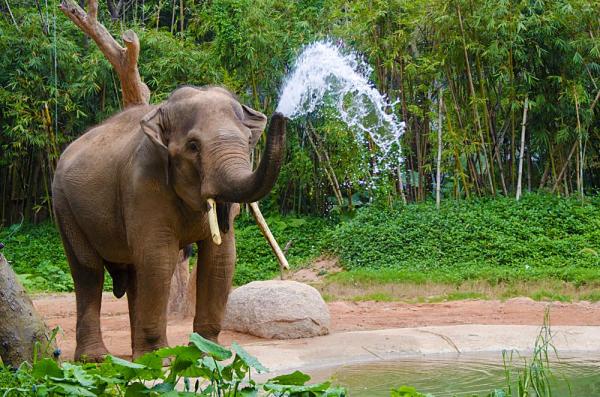When you think of Buddhism, elephants probably aren’t what comes to your mind. I’m going to guess you’re thinking more along the lines of Buddha statues, serene temples, and monks sitting in peaceful meditation. But elephant symbolism in Buddhism is highly revered for a number of reasons: from their significance in ancient legend and myth to the desirable qualities that the dignified elephant is seen embodying all over Southeast Asia today.
Table of Contents
- 1 Elephants Play a Major Role in Buddhism
- 2 What the Elephant Symbolizes in Buddhism
- 3 Other Facts About Elephants in Southeast Asia
- 4 Elephants are One of the Most Important Symbols of Buddhism
- 5 Biblical Meaning of Green Snakes in Dreams Explained [Interpretation]
- 6 Spiritual Meaning of Spiders in the Bible Explained [Good and Bad]
- 7 Spiritual Meaning of Birds in the Bible Explained [15 Examples]
- 8 Birds that Represent Freedom Explained [11 Examples]
Elephants Play a Major Role in Buddhism
Elephant symbolism has been central to the Buddhist religion since its inception. Found throughout Buddhist texts and carrying spiritual meanings, elephants are treated as royalty in their incarnations all throughout India and Southeast Asia, where Buddhism thrives.

Right from the get-go, elephant symbolism has played a crucial role in the Buddhist religion. Legend has it that the Buddha’s mother had met an elephant in her dream one night, who placed a white lotus into her womb using his tusk.
The Buddha’s mother had awakened knowing that something of great spiritual importance had occurred in her dream.
Much like the Virgin Mary, this is the story of the Buddha’s birth – and subsequently, Buddhism’s birth. For devout Buddhists then, there is no amount of gratitude in the world that can be expressed for the elephant.
The deep questions of life had pulled the Buddha away from the luxuries of his palace wall, where he lived as a sheltered prince – to go off and find the cause of suffering, a problem that had been weighing heavy on his mind.
After the Buddha’s profound awakening, while meditating underneath the bodhi tree, he discovered the cause of life’s sufferings and its cure.

The Buddha devoted the rest of his life to teaching the Four Noble Truths and the Eightfold Path across the land.
These teachings are, the Four Noble Truths:
- Suffering, pain, and misery exist in life.
- Suffering arises from attachment to desires.
- Suffering ceases when attachment to desire ceases.
- Freedom from suffering is possible by practicing the Eightfold Path.
And the Eightfold Path:
- Right understanding
- Right thought
- Right speech
- Right conduct
- Right living
- Right effort
- Right mindfulness
- Right concentration
This story and the teachings took place well over 2,000 years ago. Today they are just as relevant as ever, with an estimated 488 million people practicing Buddhism around the world.
What the Elephant Symbolizes in Buddhism
The revered elephant is treated like royalty in Southeast Asia, respected for its strong qualities. Buddhists hold the elephant in high regard for the same reasons, and more.

The elephant symbolism in Buddhism is a sign of strength, honor, patience, peacefulness, and wisdom. The Elephant is even claimed to possess the same attributes attained by the Buddha.
In the Buddhist tradition, the color of the Elephant plays a role in it’s what its symbolism stands for.
For instance: the white elephant is looked at as perfect divinity, peace, and calm. The white elephant is way more rare in the wild and is considered in some Buddhist countries to be royalty. While the gray elephant is agitated and untrained; which Buddhists use to point to the human mind when it’s first starting a meditation practice.
Here are some of the noble characteristics of the mighty elephant, which are regarded by the Buddhist faith:
Wisdom
Ancient Buddhist iconography and art famously display elephants to signify their possession of superior wisdom.
The ancient Buddhist believe that supreme knowledge comes from listening, rather than acting, which the elephant is able to do gracefully with it’s gigantic ears.
It is said that when placed on top of a pillar, the elephant awakens the Light of Knowledge, which is why the elephant is seen displayed on top of pillars in Buddhist architecture across Southeast Asia.
Strength
The Buddhist view the elephant not only as a physically strong being but a mentally strong one as well. Buddhists often liken the elephant to one’s mind, with different colored elephants signifying different stages of it.
Even the gray elephant in its recklessness is still strong. It’s the only problem is that it’s not tamed. As you could imagine, a gray elephant can do a lot of damage in an agitated stampede. Therefore, this is the perfect metaphor for the human mind.
The white elephant, like the one who met Buddha’s mother in her dream, is a symbol for a trained mind: still extremely powerful, but has directed strength which it uses for a higher good.
Peacefulness
The elephant is cool, calm, and collected when it’s not agitated. This is much like the white elephant in Buddhist symbolism. A mind that works towards enlightenment is calm, tranquil, and gentle. Due to these qualities, the elephant is also used to symbolize patience.
Honor
The elephant is honorable and loyal. These are positive qualities that we can obtain for ourselves. The elephant is viewed as loving towards its friends and focused on its path.
Other Facts About Elephants in Southeast Asia
Some Buddhist traditions keep elephants at their temples. These are trained elephants, which are referred to as “the temple elephants”.
Elephants, particularly white elephants, are viewed and treated as royalty in Thailand and Burma.
The elephant is also seen as a sign of good luck and fortune in Asian countries.
In Buddhism’s sister religion, Hinduism, there is a deity with an elephant’s head. This deity is named Lord Ganesh and is the most worshiped Hindu God. Lord Ganesh is the remover of obstacles for his worshipers.
Learn more about japa meditation here.
Elephants are One of the Most Important Symbols of Buddhism
Elephant symbolism in Buddhism is as holy to its followers as is the animal is itself. From the story of the birth of the Buddha to the desirable qualities this animal portrays; it seems like the animal has always been there to lend a helping hand in developing the Dharma.
And it’s no wonder why such a noble and majestic animal has been chosen to represent such a profound philosophy.
Leave a Reply